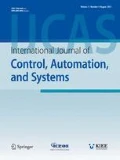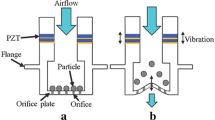Abstract
In this paper, we investigated a pyramidal hopper with extended discharge at the exit to make a bag of particles to a designated weight. Any feedback control strategy cannot be applied because the exit gate does not have any encoders to check its size, the gate size cannot be adjusted precisely during the closing motion, and the speed of the closing gate is relatively slow compared to the discharge rate of the particles. By only processing the weighing scale measurement in real time, we need to find the best point of time to start the exit gate closure of the pyramidal hopper to fill precise amount of particles into the bag. We developed and compared two control methods to determine appropriate point to initiate gate closure. First, we developed a control method by applying an empirical model describing the correlation between the gate size and the particle discharge rate, which is established by thorough experiments. Second, we developed a control method using curve fitting to predict the discharge rate of particles during gate closing motion without experiment. Both control methods were demonstrated using real time experiments, and the first one with an empirical model showed better result for final weight. This method can be directly applied to weight control of bag filling hopper without modifying the hardware system.
Similar content being viewed by others
References
Y.-K. Yeo, T.-I. Kwon, and K.-H. Lee, “An optimal model-based PID tuning method for the control of poly-butadiene latex reactor,” Studies in Surface Science and Catalysis, vol. 159, pp. 697–700, 2006.
M. Haeri, “PI design based on DMC strategy,” Transactions of the Institute of Measurement and Control, vol. 27(1), pp. 21–36, 2005.
H. Takatsu and T. Itoh, “Future needs for control theory in industry-report of the control technology survey in japanese industry,” IEEE Transactions on Control Systems Technology, vol. 7, no. 3, pp. 298–305, May 1999.
M. Canale and M. Milanese, “FMPC: A fast implementation of model predictive control,” IFAC Proceedings Volumes, vol. 38, no. 1, pp. 391–396, 2005.
M. A. Paz, T. A. Ramirez-delReal, S. C. Garibo, D. Araiza-Illan, C. A. DeLuna-Ortega, and M. O. Aguilar-Justo, “Adaptive proportional-integral controller using OLE for process control for industrial applications,” International Journal of Advanced Robotic Systems, vol. 14, no. 8, 2017.
L. Reznik, O. Ghanayem, and A. Bourmistrov, “PID plus fuzzy controller structures as a design base for industrial applications,” Engineering Applications of Artificial Intelligence, vol. 13, no. 4, pp. 419–430, 2000.
J. Y. S. Luh, “Conventional controller design for industrial robots-a tutorial,” IEEE Transactions on Systems, Man, and Cybernetics, vol. SMC-13, no. 3, pp. 298–316, 1983.
M. Yukitomo, T. Shigemasa, Y. Baba, and F. Kojima, “A two degrees of freedom control system, its features and applications,” Proc. of 5th Asian Control Conference, Australia, pp. 456–459, July 2004.
H. R. Javanmardi, M. Dehghani, A. A. Safavi, and R. Abolpour, “Model predictive control of a class of uncertain nonlinear discrete time systems: The LMI approach,” Proc. of 24th Iranian Conference on Electrical Engineering (ICEE), Iran, pp. 323–328, May 2016.
R. M. Miller, K. E. Kwok, S. L. Shah, and R. K. Wood, “Development of a stochastic predictive PID controller,” Proceedings of American Control Conference, USA, vol. 6, pp. 4204–4208, Jun 1995.
T. Shigemasa, M. Yukitomo, and R. Kuwata, “A model-driven PID control system and its case studies,” Proceedings of the International Conference on Control Applications, United Kingdom, pp. 571–576, 2002.
R. Fowler and J. Glastonbury, “The flow of granular solids through orifices,” Chemical Engineering Science, vol. 10, no. 3, pp. 150–156, 1959.
W. Beverloo, H. Leniger, and J. van de Velde, “The flow of granular solids through orifices,” Chemical Engineering Science, vol. 15, no. 3, pp. 260–269, 1961.
R. Nedderman, U. Tuzun, S. Savage, and G. Houlsby, “The flow of granular materials-I: Discharge rates from hoppers,” Chemical Engineering Science, vol. 37, no. 11, pp. 1597–1609, 1982.
S. Antony and S. Albaraki, “How does internal angle of hoppers affect granular flow? Experimental studies using digital particle image velocimetry,” Powder Technology, vol. 268, pp. 252–260, December 2014.
K. To, P.-Y. Lai, and H. K. Pak, “Jamming of granular flow in a two-dimensional hopper,” Phys. Rev. Lett., vol. 86, pp. 71–74, Jan 2001.
T. V. Nguyen, C. Brennen, and R. H. Sabersky, “Gravity flow of granular materials in conical hoppers,” Journal of Applied Mechanics, vol. 46, no. 3, pp. 529–535, 1979.
Author information
Authors and Affiliations
Corresponding author
Additional information
This work was supported by the National Research Foundation (NRF) of Korea grant funded by the Korea government (MSIT) (No. 2019R1F1A1057282). This research was supported by Basic Science Research Program through the National Research Foundation of Korea(NRF) funded by the Ministry of Education(No. 2019R1I1A3A01061919).
Jaehyun Kim received his Ph.D. degree in 2015 from the University of Texas at Austin in USA. He is currently a Professor at Hongik University in Korea. His research interests include nanoparticles, particle flow, and thermal energy systems.
Jonghoek Kim is a Professor in the Department of Electrical and Computer Engineering at Hongik University, Korea. His research is on target tracking, control theory, robotics, multi-agent systems, and optimal estimation. He worked as a senior researcher at Agency for Defense Development in Korea from 2011 to 2018. In 2011, he earned a Ph.D. degree co-advised by Dr. Fumin Zhang and Dr. Magnus Egerstedt at Georgia Institute of Technology, USA. He received his M.S. degree in electrical and computer engineering from Georgia Institute of Technology in 2008 and his B.S. degree in electrical and computer engineering from Yonsei University, Korea in 2006.
Publisher’s Note
Springer Nature remains neutral with regard to jurisdictional claims in published maps and institutional affiliations.
Rights and permissions
About this article
Cite this article
Kim, J., Kim, J. Particle Discharge Rate Analysis and Control Laws of the Exit Gate for Pyramidal Hoppers. Int. J. Control Autom. Syst. 19, 2529–2535 (2021). https://doi.org/10.1007/s12555-019-0816-8
Received:
Revised:
Accepted:
Published:
Issue Date:
DOI: https://doi.org/10.1007/s12555-019-0816-8



